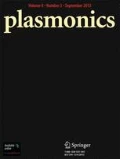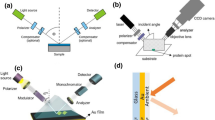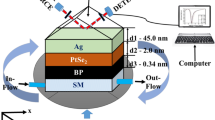Abstract
Platinum diselenide (PtSe2), an emerging two-dimensional transition metal dichalcogenide, exhibits thickness-dependent refractive index, and hence, intriguing optical properties. Here, we employ it as a plasmonic sensing substrate to achieve significant enhancement in Goos-Hänchen shift sensitivity. Through systematic optimization of all parameters, four optimum sensing configurations have been achieved at different wavelengths ranging from visible to near-infrared region, where the Goos-Hänchen shift sensitivity receives four times enhancement in comparison with the conventional bare gold sensing substrate. There is a linear range of Goos-Hänchen shift with the tiny change of refractive index for each optimal configuration. The detection limit of the refractive index change can be as low as 5 × 10−7 RIU which is estimated to be lower by 2 orders of magnitude, and the corresponding sensitivity of biomolecules has a 1000-fold increment compared with that of bare gold-based sensors.







Similar content being viewed by others
References
Goos F, Hänchen H (1947) Ein neuer und fundamentaler versuch zur totalreflexion. Ann Phys 436:333–346
Yuan L, Xiang L, Kong Y, Lu M, Lan Z, Zeng A, Wang Z (2012) Goos-Hänchen effect of spin electron beams in a parallel double δ-barrier magnetic nanostructure. Eur Phys J B 85:8
Chen X, Lu X, Wang Y, Li C (2011) Controllable Goos-Hänchen shifts and spin beam splitter for ballistic electrons in a parabolic quantum well under a uniform magnetic field. Phys Rev B 83:195409
Sakata T, Togo H, Shimokawa F (2000) Reflection-type 2×2 optical waveguide switch using the Goos-Hänchen shift effect. Appl Phys Lett 76:2841
Chen C, Lin W, Liao L, Lin Z, Chiang H, Leung P, Sijercic E, Tse WS (2007) Optical temperature sensing based on the Goos-Hänchen effect. Appl Opt 46:5347–5351
Artmann K (1948) Berechnung der seitenversetzung des totalreflektierten strahles. Ann Phys 437:87–102
Yonzon CR, Haynes CL, Zhang X, Walsh JT, Van Duyne RP (2004) A glucose biosensor based on surface-enhanced raman scattering: improved partition layer, temporal stability, reversibility, and resistance to serum protein interference. Anal Chem 76:78–85
Wang Y, Li H, Cao Z, Yu T, Shen Q, He Y (2008) Oscillating wave sensor based on the Goos-Hänchen effect. Appl Phys Lett 92:061117
Kong W, Wan Y, Li S, Zhao W, Zheng Z (2018) High-sensitivity Goos-Hänchen shift sensing based on Bloch surface wave. Sens Actuators A Physical 276:62–67
Oh GY, Kim D, Choi YW (2009) The characterization of GH shifts of surface plasmon resonance in a waveguide using the FDTD method. Opt Express 17:20714–20720
Hasib MHH, Nur JN, Rizal C, Shushama KN (2019) Improved transition metal dichalcogenides-based surface plasmon resonance biosensors. Condens Matter 4:49
Yin X, Hesselink L (2006) Goos-Hänchen shift surface plasmon resonance sensor. Appl Phys Lett 89:261108
Wan Y, Cheng M, Zheng Z, Liu K (2019) Polarization-modulated, Goos-Hänchen shift sensing for common mode drift suppression. Sensors 19:2088
Periyanagounder D, Gnanasekar P, Varadhan P, He JH, Kulandaivel J (2018) High performance, self-powered photodetectors based on a graphene/silicon schottky junction diode. J Mater Chem C 6:9545–9551
Liu B, Long M, Cai MQ, Yang J (2018) Two-dimensional van der Waals heterostructures constructed via perovskite (C4H9NH3)2XBr4 and black phosphorus. J Phys Chem Lett 9:4822–4827
Wang Y, Li L, Yao W, Song S, Sun JT, Pan J, Ren X, Li C, Okunishi E, Wang YQ, Wang E, Shao Y, Zhang YY, Yang H, Schwier EF, Iwasawa H, Shimada K, Taniguchi M, Cheng Z, Zhou S, Du S, Pennycook SJ, Pantelides ST, Gao HJ (2015) Monolayer PtSe2, a new semiconducting transition-metal-dichalcogenide, epitaxially grown by direct selenization of Pt. Nano Lett 15:4013–4018
Guo GY, Liang WY (1986) The electronic structures of platinum dichalcogenides: PtS2, PtSe2 and PtTe2. J Phys C Solid State Phys 19:995–1008
Kandemir A, Akbali B, Kahraman Z, Badalov SV, Ozcan M, Iyikanat F, Sahin H (2018) Structural, electronic and phononic properties of PtSe2: from monolayer to bulk. Semicond Sci Technol 33:085002
Xie J, Zhang D, Yan XQ, Ren M, Zhao X, Liu F et al (2019) Optical properties of chemical vapor deposition-grown PtSe2 characterized by spectroscopic ellipsometry. 2D Mater 6:035011
Zhuang HL, Hennig RG (2013) Computational search for single-layer transition-metal dichalcogenide photocatalysts. J Phys Chem C 117:20440–20445
Zhao Y, Qiao J, Yu Z, Yu P, Xu K, Lau SP, Zhou W, Liu Z, Wang X, Ji W (2017) High-electron-mobility and air-stable 2D layered PtSe2 FETs. Adv Mater 29:1604230
Yim C, Lee K, McEvoy N, O’Brien M, Riazimehr S, Berner NC, Cullen CP, Kotakoski J, Meyer JC, Lemme MC, Duesberg GS (2016) High-performance hybrid electronic devices from layered PtSe2 films grown at low temperature. ACS Nano 10:9550–9558
Ciarrocchi A, Avsar A, Ovchinnikov D, Kis A (2018) Thickness-modulated metal-to-semiconductor transformation in a transition metal dichalcogenide. Nat Commun 9:919
Bruna M, Borini S (2009) Optical constants of graphene layers in the visible range. Appl Phys Lett 94:031901
Ouyang Q, Zeng S, Jiang L, Hong L, Xu G, Dinh XQ, Qian J, He S, Qu J, Coquet P, Yong KT (2016) Sensitivity enhancement of transition metal dichalcogenides/silicon nanostructure-based surface plasmon resonance biosensor. Sci Rep 6:28190
Refractive index database. Available at: http://refractiveindex.info
Johnson PB, Christy RW (1974) Optical constants of transition metals: Ti, V, Cr, Mn, Fe, Co, Ni, and Pd. Phys Rev B 9:5056–5070
Gupta BD, Sharma AK (2005) Sensitivity evaluation of a multi-layered surface plasmon resonance-based fiber optic sensor: a theoretical study. Sensors Actuators B Chem 107:40–46
Verma R, Gupta BD, Jha R (2011) Sensitivity enhancement of a surface plasmon resonance based biomolecules sensor using graphene and silicon layers. Sensors Actuators B Chem 160:623–631
Ouyang Q, Zeng S, Jiang L, Qu J, Dinh XQ, Qian J, He S, Coquet P, Yong KT (2017) Two-dimensional transition metal dichalcogenide enhanced phase-sensitive plasmonic biosensors: theoretical insight. J Phys Chem C 121:6282–6289
Taya SA, El-Farram EJ, El-Agez TM (2012) Goos-Hänchen shift as a probe in evanescent slab waveguide sensors. Int J Electron Commun (AEU) 66:204–210
Funding
This work is supported by the National Natural Science Foundation of China (grant no. 11304070), the Singapore National Research Foundation and French National Research Agency grant NRF2017–ANR002 2DPS, China Scholarship Council.
Author information
Authors and Affiliations
Corresponding authors
Additional information
Publisher’s Note
Springer Nature remains neutral with regard to jurisdictional claims in published maps and institutional affiliations.
Electronic Supplementary Material
ESM 1
(DOCX 4253 kb)
Rights and permissions
About this article
Cite this article
Guo, Y., Singh, N.M., Das, C.M. et al. Two-dimensional PtSe2 Theoretically Enhanced Goos-Hänchen Shift Sensitive Plasmonic Biosensors. Plasmonics 15, 1815–1826 (2020). https://doi.org/10.1007/s11468-020-01204-9
Received:
Accepted:
Published:
Issue Date:
DOI: https://doi.org/10.1007/s11468-020-01204-9




